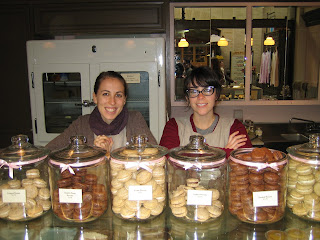
I'm always happy when a sugar cookie holiday rolls around.
You know, those occasions when it is time to break out the sprinkles and cookie cutters.
From the time my daughter was very small, we enjoyed baking and decorating sugar cookies for not only the typical sugar cookie holidays like Valentine's Day or Christmas, but we also took every opportunity to make up our own special occasions to break out the cookie sheets.
We weren't fans of icing but we did eventually branch out beyond colored sugar to the fancy shaped sprinkles.

My daughter would take about five minutes per cookie putting each individual grain of sugar on the cookie but maybe it just seemed that way to her overly efficient mother.
The days of her helping decorate sugar cookies are long gone but I still can't let a holiday go by without breaking out the cookie cutters. And I'm always on the lookout for unusual cookie cutters -- I just snagged a cookie cutter in the shape of a martini glass from Surfas Restaurant Supply in Los Angeles that I will use at our next cocktail party.
And yard sales are a surprising source of fun cookie cutters. I'm always amazed at the unopened boxes of cookie cutters I find at yard sales. I always imagine that the owner in a fit of baking optimism bought them but lost their enthusiasm when faced with the actual task of pulling out ingredients and mixing bowls. Of course, I have to give them a good home. The most unusual box of cutters I have come across is of vegetable shapes -- I especially like the celery shaped one...
Our sugar cookies were always thicker than the typical sugar cookie -- we don't like them crispy but instead as soft as possible. I keep an eye on the timer and take them out when the bottoms are just barely starting to turn brown.
I do this because despite the thousands of sugar cookies that I must have baked over the years, I've yet to find a sugar cookie that resembles the one I had growing up in Indiana.
My mom worked full time and had five children so she often found herself doing her grocery shopping on a Friday night.
I would often accompany her on these shopping trips before I turned into a teenager and stopped leaving my room. My reward for tagging along to keep her company was one gigantic sugar cookie from the grocery store bakery. And this was in the days before serving sizes got out of control.
This cookie was a beauty. As I said it was large -- about five inches wide. It was snow white, about an inch thick in the middle tapering down to 1/2 inch at the edge. I would usually break it in half so I could get to the center part right away. The center was puffy soft, and seemed to evaporate on my tongue with only the crumbs as evidence that there had been a cookie consumed.
As a grownup I would often spy a cookie that resembled it in a bakery case but I was always disappointed by the taste and texture of that impostor. Nothing could approach the softness and slightly tangy flavor of this sugar cookie.
But then (thanks to Celia Sacks of Omnivore Books on Food in SF) I came across Marcia Adams' classic cookbook, Cooking from Quilt Country: Hearty Recipes from Amish and Mennonite Kitchens. In this classic cookbook Adams shares family recipes from the Indiana Amish and Mennonites.
And there it was, just like that -- Big White Soft Sugar Cookies -- yes, that is the actual name of the recipe!
Adams described these cookies, "It comes very close to those cookies of our memories -- white, soft and cakelike, with just a touch of nutmeg."
The final evidence was when she said, "The cookies should be just barely done -- still almost white. If they are golden, you have left them in too long."
Now that I knew what I was looking for I started finding similar recipes: The All-American Cookie Book by Nancy Baggett has a recipe for Pennsylvania Dutch Soft Sugar Cookies and Anita Chu in her book, Field Guide to Cookies, gives us Nazareth Sugar Cookies (as in Nazareth, Pennsylvania), a "soft and fluffy sugar cookie."
The recipes were similar in that they all made a cakelike and saucer-sized sugar cookie and most required that the dough rest overnight. The recipes differed in a few ingredients with the biggest difference being in the choice of either sour cream or buttermilk.
And although I don't remember it, it appears to be traditional to decorate the sugar cakes with a raisin in the center.
I used a combination of several recipes to come up with my own. I no longer needed them to be saucer-size but it was fun to make a few large and some more the size of an espresso saucer instead.
I was a bit nervous as I waited for them to bake. But they tasted just as I remembered. Although I don't think my daughter or husband thought they were that special -- I actually think they thought they tasted rather bland. But that is the beauty of a memory -- it belongs to the one looking back after all.
And now I want to remember Dorothy Hanna, my mom and the inspiration for this blog. She passed away a year ago this month. She is missed.
Mom, thanks for the sugar cookies but most of all, thanks for the sweet memories.










